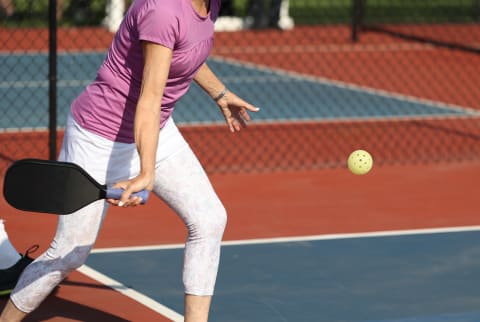Advertisement
Why Is Everyone Getting Injured From Playing Pickleball?


Let's be clear up top: We are not anti-pickleball around here. It gets you outdoors! It's adaptable for any age! It's good for your brain! And most importantly—it's fun!
"We have lost this narrative about the importance of play," mobility pioneer and certified precision nutrition coach Juliet Starret shares on the mindbodygreen podcast. "It's one of the reasons why I think pickleball is so important and awesome that it's become so popular."
While we believe the best exercise is the one you'll do, there's something about heading to the gym by yourself that can feel austere or intimidating. "Anytime we can add in something that helps our bodies be durable and is playful is a gigantic win for humans," Starrett adds. Pickleball ticks both boxes.
mindbodygreen Functional Nutrition Training
Learn how to use food as medicine with a cutting-edge nutrition deep dive taught by the world's foremost health & wellness experts. Learn more about mindbodygreen's Functional Nutrition Training.
According to the experts, it's a little more nuanced than that.
Why do people get injured from pickleball?
Even those generally considered "fit" and "lean" are not immune to these injuries. Why? Two main reasons.
Ignoring your mobility
According to physical therapist Kelly Starrett, who (along with his wife, Juliet) has spent decades working with pro athletes, Olympians, and Navy SEALs, there's a big difference between staying active and maintaining optimal mobility.
"We have a lot of people who have been only [spinning] or running, where they're just doing something in a single direction or a single position," he notes. "Chances are their workout regimen outside of pickleball is very linear."
Then when they lunge and change directions at high speeds for hours on end, joints and tissues literally start to crumble. "You did your one hour of elliptical, and you thought that was going to prepare and load your tissues. It wasn't," Kelly adds.
But it's not your fault: "This is our industry," he explains. As a society, we're encouraged to exercise for an hour or two per day—either cardio or strength training—and believe that's enough to check our "movement box." However, "it turns out to be not enough total movement in the day," Juliet notes. And if you don't load your feet and maintain your springiness, you aren't preparing your body for the sport as well as you could be.
Advertisement
Pushing yourself too far
Of course, we'd be remiss not to mention the age-related component here. You likely can't perform at the same speed at 55 as you did when you were 25. Yet many people either ignore their limits or simply don't realize they're pushing themselves to the max—and injuries arise.
"When you are picking up something new when you haven't been as active in a long time, it's important to be measured about it," says award-winning sports journalist Christine Yu on the mindbodygreen podcast. "That's really hard in our society, because we just want to go out and do all the things. A lot of folks tend to be competitive, or they may have played sports when they were younger and want to recreate that feeling. But you have to respect your body right where it is."
How to prevent pickleball injuries
Keep these tips in mind before picking up the paddle:
Play & jump
"You know, who never gets injured playing pickleball? All the adults who are in those small soccer pickup games," Kelly explains. "There's so much lateral movement and cutting."
That's not to say you must join a competitive soccer league, but try to add more sport and play into your exercise regimen if you can. These activities help train your body for a diverse range of movements so your joints aren't as surprised when they hit the pickleball court.
Advertisement
Kelly also jumps rope every single day. "I am trying to maintain my springiness, so I'm loading my feet in a whole bunch of different ways," he adds. He recommends performing 200 single jumps with your toes together and your glutes engaged. Next, do 100 jumps on your left foot and 100 jumps on your right foot before calling it a day.
Eat more protein
"If we took a physical therapy view, [we'll likely say], 'Hey, you don't eat enough protein. There are no micronutrients,'" says Kelly.
See, to heal and rebuild2
Protein intake can also impact your recovery from injuries, too: One study even found that eating protein can accelerate the recovery of hip fractures3
Here, find our expert guide to eating more protein, plus a protein-packed grocery list to keep on-hand.
Rest & recover
It's easier said than done, but know your limits. "In my 20s, I could get away with a whole lot of stuff that I wouldn't be able to get away with now," notes Yu. "I need to make sure that I'm resting and recovering because my body needs more of that time."
Advertisement
Pickleball can get competitive—that's fine! Just don't dive and slide for the ball like you might have done when you were younger. "It's about recognizing how the needs of your body might shift with age and accommodating that," Yu adds. Essentially: Give yourself grace.
The takeaway
Pickleball injuries are increasingly common, especially in adults over 50 who aren't as resilient to joint stress. To prevent the statistic from becoming your reality, it's important to focus on a range of movement that strengthens your agility, not just a single-direction exercise.
And if it's been a while since you've used those connective tissues, allow yourself some time to warm up to the game (and know when to recover). See you on the court.
